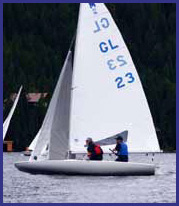
|
Fleet Information
| National Class E Scow Association Website When you are talking about the ultimate sailing boat with speed, performance and crew work, you are talking about the E Scow. Originally designed in the Midwest, the E Scow was adopted by the Inland Lake Yachting Association in 1924. The National Class E Scow Association (NCESA) tested an asymmetrical spinnaker option as a potential change to the design scantlings for two years with scattered individuals and a few fleets converting to the test rig. The asymmetrical spinnaker was voted down by the class in 2006, but revisited after the 2007 season with a modified proposal and with a slightly modified rig and more restricted spinnaker shape. The vote passed. Starting in 2008 asymmetrical spinnakers will be allowed and the GLYC fleet is committed to making that change with conversions occurring in April and May of 2008. |
| The M-20 scow was designed by Harry Melges Sr. and Harry (Buddy) Melges Jr. in 1963 as the scow version of the Olympic Flying Dutchman class. The M-20 is 20' long and 5'8" wide. The M-20 carries 176 square feet of sail and a powerful 300 square foot spinnaker for offwind speed. A full set of sail adjustments keep the skipper and crew on their toes. An adjustable permanent backstay and flexible spar allow competitive crew weights to range from 270 to 450 pounds. As a result, the M-20 is very popular with families. Grand Lake boasts one of the largest active M-20 scow fleets in the world with over 20 yachts competing each summer. |
| The Melges 17 is the latest addition to the GLYC. Built to handle a crew of two, the M17T incorporates some of the most innovative sailboat engineering concepts. With a total sail area of 500 square feet, a hull weight of just 300 lbs, a beam of just under 6 feet, and a total weight of 300 pounds, the M17 is a rocket! Sporting a high tech asymmetrical spinnaker, a roller furling Kevlar® jib with recessed roller furler, self-stepping mast design, and foil bilge boards, the M17 makes for an edge-of-your-seat racing experience. |
| M-16 North American M-Scow Association The original 2 sailor scow, the M16 scow is solid and relatively easy to sail. With over 20 M16's on Grand Lake, this is an excellent craft for family crews and younger sailors alike. Featuring a 16 foot length and a width of just under 6 feet, the boat is easy to sail and easy to fall in love with! |
| Designed by Reichel/Pugh and built by Melges, the Melges 15 prioritizes stability, comfort, ease of use, and performance. The Melges 15’s stable hull shape and ergonomic cockpit make it a suitable layout for adult racing and educational sailing. With its easy conversion from a club configuration (non-spinnaker) to a one-design setup, the M-15 provides versatility to club programs and options for individual owners. |
| International Laser Class Association The Laser is a world-renowned single-handed One Design. In gusty winds, it's a true test of strength and courage and is sailed by both adult and junior racers in several different GLYC summer competitions. First designed and built in 1971, the Laser was officially unveiled at the New York Boat Show in 1971. The Laser became a men's Olympic-class boat in 1996, and a special Olympic edition of the boat was released that year in commemoration. A version with a smaller sail, the Laser Radial (see below), will be a women's Olympic-class boat beginning in 2008. As a one-design class of sailboat, all Lasers are built to the same specifications. The hull is 4.23 metres (13 ft 10.5 in) long, with a waterline length of 3.81 m (12.5 ft). The hull weight is 56.7 kg (130 lb), which makes the boat light enough to lift onto a car-top rack. The Laser Standard sail has sail area of 7.06 m² (76 ft²) and, especially in higher winds, is most competitive when sailed by a muscular person weighing more than 80 kg (175 lb). |
| 1128 Lake Avenue, Grand Lake CO PO Box 983, Granby, CO 80446 |




.jpg)

.jpg)